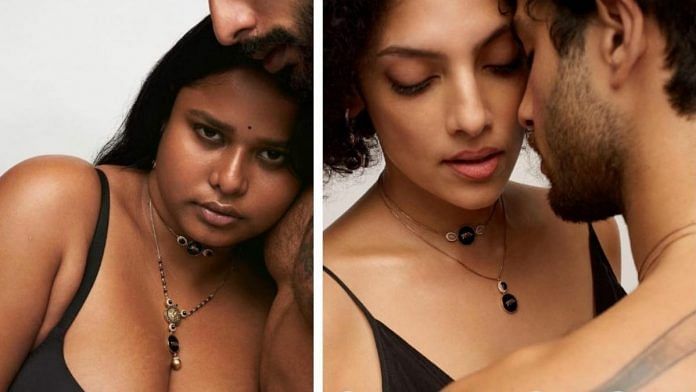You’d think that a modern take on a tradition that risks dying out would be a sure-shot sell in India, but fashion designer Sabyasachi’s latest series of advertisement made a fatal mistake — portraying an average mangalsutra wearing woman as someone who willingly and unabashedly embraces her sexual desires.
Mangalsutra — which translates to an auspicious thread — is a customary necklace worn by many Hindu women after marriage. While any item that ‘marks’ a woman’s marital status is oppressive and patriarchal, let’s for the sake of this article say that a mangalsutra has been a proud symbol for many women of their commitment to their husbands. Thus, the mangalsutra, by extension, becomes a symbol of a woman enjoying a socially approved, marriage-sanctioned active sex life. We are talking about consensual ones.
Sabyasachi, the brand, has become increasingly associated with weddings in India since the rich and famous all choose the Kolkata designer’s clothes for any marriage ceremony. So, obviously, he went for the mangalsutra next. But while premarital sex remains a taboo in India, many couldn’t digest Sabyasachi’s new ad showing a presumably married woman, given her mangalsutra and bindi, being intimate.
The ad campaign, which includes depictions of LGBTQ couples, led to outrage on social media from the usual Right-wing self-appointed guardians of the Hindu culture. They called it ‘obscene’ and asked for the ad to be taken down. This comes on the heels of Dabur taking down its Karva Chauth ad showing a lesbian couple after BJP anger.
Also read: Sabyasachi x H&M shows everyone has a hot take, even at cost of pulling down Indian talent
Who is a married woman?
Majority of those outraging seem to have a problem with one particular model — Varshita Thatavarthi, the dusky, plus-sized model and Sabyasachi’s latest muse.
Thatavarthi is flaunting the reimagined mangalsutra while wearing lingerie. Her head resting on the chest of a male model, she gazes right into the camera.
And that is a perfect mix of what scares the Right-wing extremists today, isn’t it? An Indian woman confident with her body, not shying behind dupattas and pallus, embracing her sexuality — turning a symbol of patriarchy into a symbol of sexual empowerment and being unapologetic about it. Many orthodox parents say, beta do what you like after marriage. The outrage against this ad shows clearly you can’t.
In 2015, a group of women in Tamil Nadu protested by taking off their mangalsutras, calling it a symbol of a woman’s slavery and the man’s control over his wife’s body.
Indeed, why are these symbols of lifelong bond with one’s spouse all for women? There is sindur, churas, shakha pola — and the mangalsutra — for women. Where is the man’s marker of his undying love for his spouse? And what of the LGBTQ community who are still ineligible to get married to their partners under the rigorous Indian laws?
Enter Sabyasachi — lending a luxury status to the humble mangalsutra, giving it a revamp that is inclusive of all genders and sexual orientations when more and more women are shunning it. I may not agree with the institution of marriage, or Sabyasachi’s philosophy of appropriating Indian traditions, but I am surprised that Hindus do not see this as an attempt to keep their traditions alive in the modern world.
It’s not that the Hindu Right-wingers do not like their ancient traditions wrapped in modernity. Ayurveda is a classic example of how ancient ‘remedies’ packed into modern plastic bottles make a booming industry.
Also read: You can be LGBTQ and patriarchal. Dabur Fem’s Karva Chauth ad shows that
Sabyasachi crosses ‘Lakshman rekha’
So, precisely, what makes the Sabyasachi ad vulgar?
It’s the proverbial ‘lakshman rekha’ that separates duty and subservience in marriage from pleasure in the bedroom.
The ideal Bharatiya nari has sex only after marriage to procreate. She is apologetic about her breasts and skin and does her best to hide them under layers of fabric. She tries to be thin and fair-skinned. She thinks more about household chores than her desires. Sexual relations with her husband is her duty, to such an extent, that even the courts refuse to intervene if she is raped by her husband.
So, how dare a designer suggest that a married Hindu woman may have sex with her husband for pleasure. How dare she look so much like the Indian girl-next-door, and have the impunity to look us in the eye? How dare she not cover up?
I’ll go so far as to concede that bras are in fact a Western concept. In Khajuraho, the goddesses flaunt necklaces on bare chests. Hindu women in fact did not cover their chests until a few hundred years ago. While salwar kameez has Mughal influence, the concept of Sari blouses had a British hand.
Hindu culture has continuously adapted to modern sensibilities and changed with Western influences. If you want to save your precious traditions from becoming irrelevant and obsolete, it would be prudent to bend to the winds of change.
Views are personal.
(Edited by Neera Majumdar)



